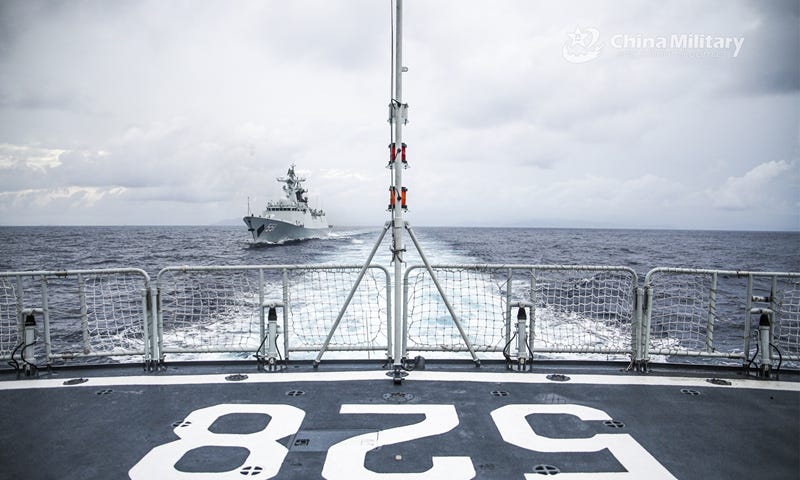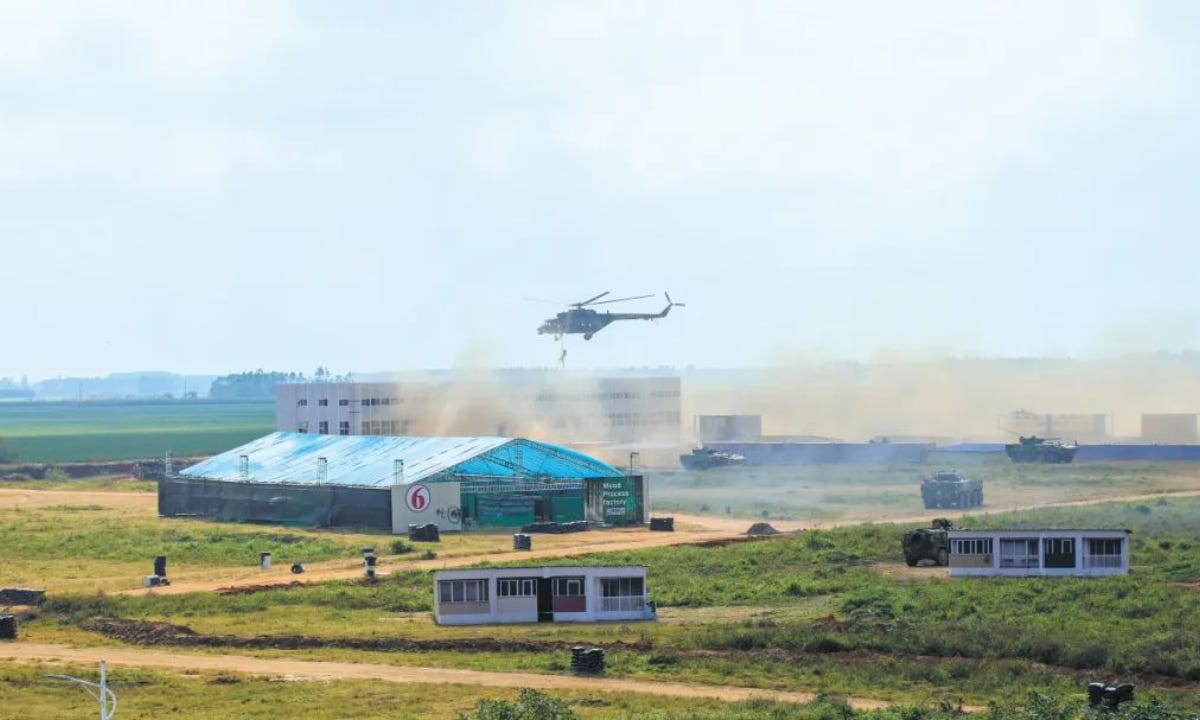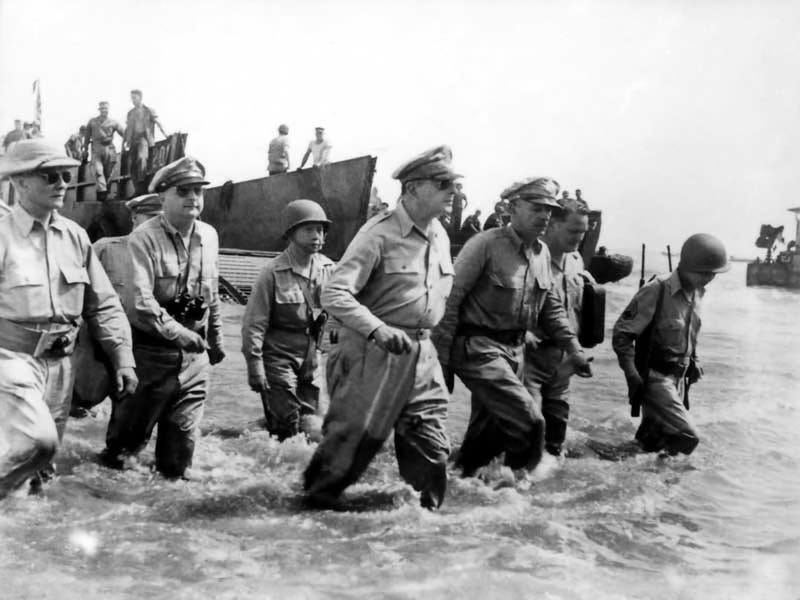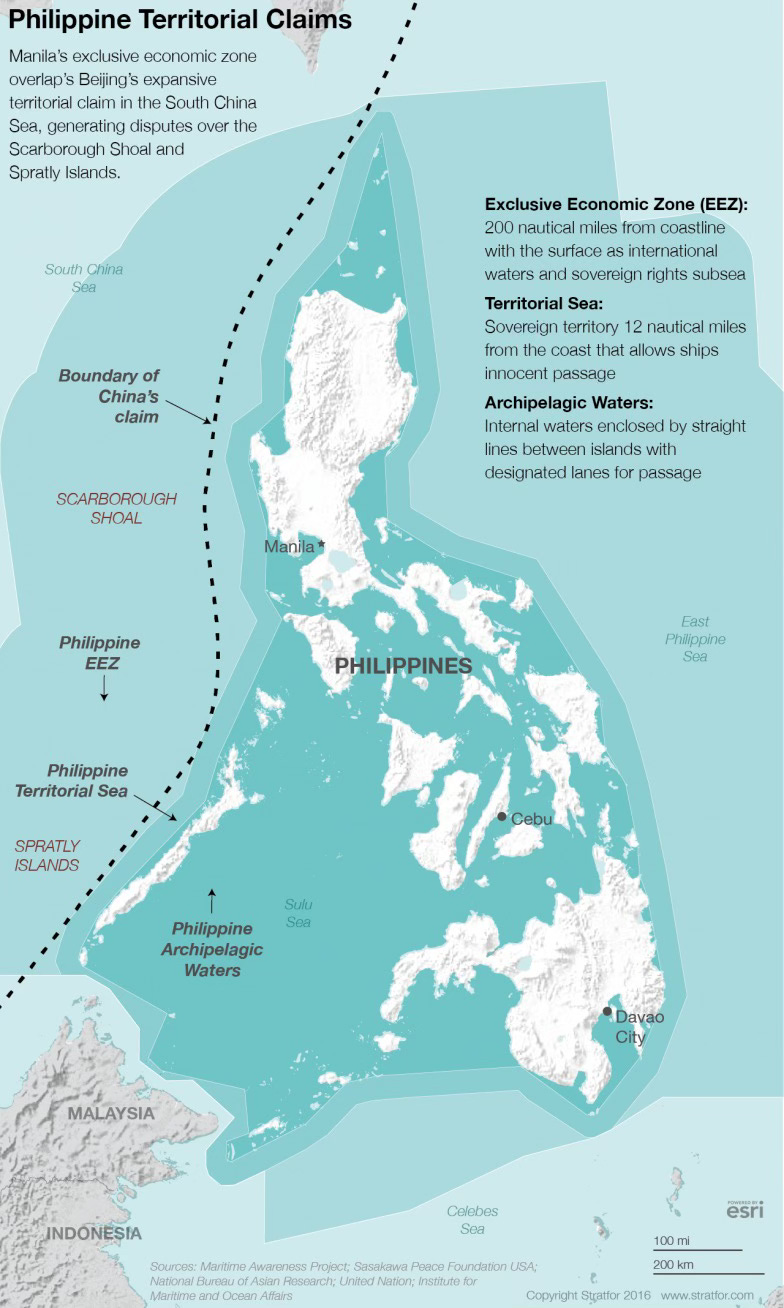Marcos Redux
UPDATE: The Chinese People's Liberation Army (PLA) was at the scene and on high alert when the US and Philippines launched a joint patrol in the South China Sea on Tuesday, with experts saying on Thursday that the PLA's presence deterred potential provocations and displayed China's capabilities in safeguarding national sovereignty, security and maritime interests.
Marcos Jr. “Number one is securing the peace in the West Philippine Sea (WPS). The Indo-Pacific region, particularly the West Philippine Sea, is in the middle of a global geopolitical transformation and has become an arena of normative contestation.”
An ongoing military exercise hosted by China and joined by five Southeast Asian countries has entered its actual combat phase. Participated by ground, maritime and aviation forces, the drills will comprehensively enhance participants’ interoperability and trust, experts said on Thursday.

PLA on high alert amid US-Philippines joint patrols in South China Sea
By Liu Xuanzun and Guo Yuandan
The Chinese People's Liberation Army (PLA) was at the scene and on high alert when the US and Philippines launched a joint patrol in the South China Sea on Tuesday, with experts saying on Thursday that the PLA's presence deterred potential provocations and displayed China's capabilities in safeguarding national sovereignty, security and maritime interests.
The frigate Yuncheng affiliated with the navy of the PLA Southern Theater Command has been conducting a routine patrol in waters in the South China Sea since Tuesday, Senior Colonel Tian Junli, a spokesperson of the command, said in a press release on Thursday.
During the PLA warship's patrol, the Philippines rallied forces from outside the region and conducted a patrol in the South China Sea, stirred up tensions and troubles and hyped the event, Tian said.
The Philippines' move sabotaged regional peace and stability, and violated the spirit of the Declaration on the Conduct of Parties in the South China Sea, the spokesperson said.
"The command troops maintained high alert to firmly defend national sovereignty, security and maritime interests, and firmly safeguard peace and stability in the South China Sea," Tian said.
Tian's statement came after the Philippines launched a three-day joint air and maritime patrol with the US on Tuesday stretching from the Philippines' northernmost point near the island of Taiwan to the South China Sea, Reuters reported on the day.
Participating forces included three naval vessels, two FA-50 light combat aircraft and an A-29B light attack plane from the Philippine side, and a littoral combat ship and a P-8A Poseidon maritime patrol and reconnaissance aircraft from the US side, Reuters said.
Wei Dongxu, a Beijing-based military expert, told the Global Times that the US and Philippine forces deployed in the joint patrol have only limited capabilities.
A PLA Navy Type 054A frigate and a Y-9 surveillance aircraft kept watch on the US-Philippines joint patrol, Philippine Daily Inquirer reported on Thursday.
Zhang Junshe, a Chinese naval expert, told the Global Times on Thursday that the PLA presence during the US-Philippine joint patrol served as a deterrent force, and showed that China has the capability in safeguarding national sovereignty, security and maritime interests.
The Philippines' rallying of forces from outside the region only gave them the chance to interfere in the South China Sea issue and sabotage peace and stability in the region, which is also harmful to the Philippines' own national sovereignty and security, Zhang said.
The only right path for the Philippines is to return to talks and negotiations with China and resolve disputes through peaceful means, Zhang said. "The more the Philippines provokes, the heavier it will end up landing," he said.
Read more here.
Marcos Jr. on Security
Thank you very much for your kind introduction, the Director of the DKI APCSS, Director Pete Gumataotao; the DKI Institute Director Jennifer Sabas; the APCSS Foundation President, Gerald Sumida; Her Excellency MaryKay Carlson, the US Ambassador to the Philippines; the USINDOPACOM Commander Admiral John Aquilino; members of the Philippine delegation; other distinguished guests; ladies and gentlemen, good afternoon. And I think the traditional greeting is aloha. Aloha!
I am very pleased to be able to speak with you today here, especially since it is a particular pleasure that I am here at the Daniel Inouye Center.
As has been mentioned, Senator Inouye was a great friend of my father and equally importantly a great friend of the Philippines.
As a matter of fact, one of his last acts in Congress that involved the Philippines was that he was able to finally arrange for the backpay of the so-called Bolomen that fought together with the Americans during the Second World War.
And I wrote him a letter and he responded to me and we were both very, very pleased and just a little bit sorry that my father was not here--- was not around to notice--- to note what had been achieved and what he had been working for since the end of the last war.
So, this event caps the six-day, three-city working visit to the United States, which I have just undertaken. It is my third visit since I assumed the presidency in 2022.
This Honolulu leg is of course, been of a special one for many reasons. First of all, Hawaii is home to a significant number of Filipinos and Filipino-Americans, many of whom--- the original immigrant workers came from my home province or my home region of Ilocos Norte, which is the northern part of the Philippines.
The Ilocos-Hawaii connection began here with our so-called sakadas or workers, arriving in 1906 as plantation workers.
And then, as events conspired, Filipinos were also fighting shoulder to shoulder with American soldiers during the war. Today, Honolulu hosts the headquarters of the U.S. Indo-Pacific Command (INDOPACOM). The long-standing partnership between the Armed Forces of the Philippines (AFP) and the INDOPACOM have resulted in enhanced coordination, interoperability, and individual and joint defense capabilities.
This is to ensure that we both uphold our commitment to our treaty alliance, especially in the face of growing and evolving regional and global challenges to our security.
It's no coincidence that I spent this morning before coming here with Admiral John Aquilino.
We had a very productive and useful exchange on regional developments and the critical role of the Philippine-U.S. alliance to promote peace, and to safeguard the international law-based order to ensure resilient, sustainable, and inclusive growth for our economies and our communities.
It is the third visit that I have made to the United States since becoming President and in this visit I have had the privilege to speak about my vision for the Philippines and the world through the platforms provided by the Asia Society in New York, the CSIS in Washington, and now here in the APCSS here in the Aloha State.
My message has always been firm, simple, and clear: the Philippines will continue to be an engaged and responsible neighbour and partner— always finding ways to collaborate with the end goal of mutually beneficial outcomes, namely, peace, stability, and prosperity in the Indo-Pacific Region — it is through working together, guided by the rules-based international order, that we can ensure an environment that will allow our countries and our peoples to prosper. That has been the raison d’être for my foreign policy of peace.
There are many challenges, however, in the roads towards that peaceful and prosperous future that we envision. Signs of another nuclear and space arms race are hovering over us.
We are caught between the dual challenge of opportunity and presented by advanced and emerging technologies — chief of which, of course, is AI. Smaller countries like the Philippines are grappling with the need to enhance our security capabilities alongside allies and partners and amidst larger regional players.
So, allow me this afternoon to speak more specifically about the two challenges that I believe are the most crucial to our common aspirations now.
Number one is securing the peace in the West Philippine Sea (WPS). The Indo-Pacific region, particularly the West Philippine Sea, is in the middle of a global geopolitical transformation and has become an arena of normative contestation.
Tensions in the West Philippine Sea are growing, with persistent unlawful threats and challenges against Philippine sovereign rights and jurisdiction over our exclusive economic zone (EEZ) and the continental shelf—actions that violate obligations under international law, particularly the 1982 UN Convention on the Law of the Sea or UNCLOS and the 2002 Declaration on the Conduct of the Parties in the South China Sea (DOC).
Our regular routine and resupply missions at Ayungin shoal are subjective to coercive tactics and dangerous maneuvers of coast guard and maritime militia vessels in the West Philippine Sea, putting the lives of our people at risk, and challenging the rule of law in that--- that has defined our baselines, our economic zone, and the maritime territory of the Philippines.
There is rampant illegal, unreported, and unregulated (IUU) fishing, and militarisation of reclaimed features in the South China Sea. There have been recent missions to Escoda (Sabina) and Romulo (Iroquois) Reef which revealed a direct correlation between the presence of maritime militia vessels and reef damage in those features. If only for that, the impact on biodiversity and the environment are--- I’m afraid are assessed as possibly already irreversible. This imperils livelihoods. This imperils the future generations of Filipinos.
So, I have said it before and I will say it again, the Philippines will not give a single square inch of our territory to any foreign power. The law is clear as defined by the UNCLOS and the final and binding 2016 Award on the South China Sea Arbitration. Supported by the rules-based international order and our growing partnerships, both time-tested and new once, we will insist on the preservation of the sovereignty and integrity of the country, while working closely with international partners in the bilateral, regional, and multilateral settings in developing rules and processes to address these challenges.
We appreciate certainly the concrete manifestations of the U.S.’ and the growing number of our other partners in support for the Philippines’ position.
The strong, factual messaging in support of our lawful exercise of our rights under international law, and which will call out recent incidents in our EEZ, it demonstrates the strength of our alliance and partnership and challenges attempts to perpetuate false narratives.
That has become a very important front in all of these events that are happening in and around the Philippines. But unfortunately, rhetoric is not enough.
We need to upgrade our defense and civilian law enforcement capabilities not only to defend ourselves but also to enable us to become a reliable partner in promoting and guaranteeing regional security. That would require greater substantial infusions into funding streams needed for our armed forces and coast guard modernisation plans, including lines of effort to enhance cyber cooperation.I am optimistic from our recent engagements with our American counterparts, including U.S. legislators, and certainly in the executive department to elevate our partnership and dedicate resources to match our commitments.
Over the past week, our teams have been working on a bilateral planning and tracking mechanism that is expected to accelerate concrete and substantial capability development investments and activities in order to meet our shared defense and security objectives over the next 5 years. Our defense secretaries also just met in Jakarta on the sidelines of the ASEAN Defense Ministers Meeting Plus, to discuss efforts to further strengthen our alliance.
The second item that I feel is very important is the securing strategic sectors and critical infrastructure, and especially, as we have all begun to recognize the importance of activities in cyberspace.
At the same time, ladies and gentlemen, we also need to address broader notions of security, and that now will include economic security.
We welcome public-private partnerships, particularly engagements between and outside our military and defense establishments.
For example, the Agila Subic Shipyard project supports Philippine efforts to position Subic Bay as a logistics hub and complements HADR readiness and initiatives. USAID development projects can also be harnessed to help boost our economic resilience. We hope to expand these partnerships in critical and strategic sectors and infrastructure.
Just the other day, I witnessed on the sidelines of the APEC Summit in San Francisco the signing of the Philippines-United States Agreement for Cooperation Concerning Peaceful Uses of Nuclear Energy, or what is more commonly known as the 123 Agreement. This opens the doors for U.S. companies to invest and to participate in nuclear power projects in the Philippines. This is expected to boost national efforts towards securing an affordable, reliable, and sustainable energy supply.
Our cooperation on cybersecurity is also a priority, as it impacts both national and economic security.
Critical infrastructure, whether with respect to ports, to energy, telecommunications, they will require cybersecurity measures to be in place for the country to be resilient.
These systems form the backbone of our military infrastructure, our hospital systems, our agriculture, manufacturing, services sectors.
In September, we launched the 2023-2032 National Innovation Agenda and Strategy Document (NIASD). This is the Philippine government's 10-year innovation plan establishing the country's goals and strategies to improve innovation governance and establish a dynamic innovation ecosystem in critical areas, learning and education forexample, health, food and agribusiness, finance, manufacturing and trade, transportation and logistics, public administration, security and defense, energy, blue economy and water supply.
We anticipate many areas where the U.S., as a leader in innovation and emerging technology, can also be our major partner.
Our teams are looking to convene the inaugural interagency PH-U.S. Cyber Dialogue sometime early next year to follow through on our commitment to enhance cooperation in the face of new and emerging threats, including completing a full assessment of the cyber threat landscape and the establishment of next steps to counter cyber threats.
So, friends, ladies and gentlemen, these challenges will continue to evolve, but I am confident that, together, we will be able to manage them.
Our alliance is stronger than ever because it has been founded on our shared values, our mutual respect and trust of each other as equal, sovereign partners, and the unbreakable bonds between our two peoples.
Our recent engagements across branches and levels of government confirm that we are committed to this relationship for the long term.
At the same time, our growing network of partners, including Australia, Japan, the Republic of Korea, the UK, European Union will serve as force multipliers which will help us bring our country closer to the vision of a peaceful, secure, and prosperous nation, within a secure and prosperous region.
So, I hope to continue this dialogue with all of you as we make our way on this principled path that we have chosen.
We today are defining the future, the future for ourselves in our lifetime but also for the generations to come.
Thank you very much. Mahalo Nui Loa. [applause]
--- END ---
Watch Youtube version here.

China-hosted joint drills with SE Asian countries enter combat phase
By Liu Xuanzun
An ongoing military exercise hosted by China and joined by five Southeast Asian countries has entered its actual combat phase. Participated by ground, maritime and aviation forces, the drills will comprehensively enhance participants’ interoperability and trust, experts said on Thursday.
Separated into land part and sea activities, the actual combat drills of the Aman Youyi-2023 multinational joint exercise started on Wednesday, the PLA Daily reported on Thursday.
In the land drills sections, troops from China, Cambodia, Laos, Malaysia, Thailand and Vietnam commenced an elimination mission over mock terrorists who entrenched in simulated city blocks, applying tactics including air-land integration and multidimensional encirclement, and successfully rescued simulated hostages.
A photo released with the PLA Daily report showed wheeled infantry fighting vehicles and tactical assault vehicles surrounded buildings while a helicopter hosted rappelling mid-air.
An anti-piracy actual combat exercise at sea was held simultaneously with the land drills.
The Type 052D destroyerNanning, the Type 054A frigateBayannaoer, the Type 903 comprehensive replenishment shipWeishanhuand the Type 056A corvetteSuqianof the Chinese Navy formed a task group with theSelangoroffshore patrol vessel of the Malaysian navy and theQuang Trungfrigate of the Vietnamese navy.
As the task group locked on the target, theBayannaoerleft the group and spearheaded an assault on the mother ship of the mock pirates, while theNanning, theSelangorand theQuang Trungcoordinated flexibly and surrounded a simulated cargo ship hijacked by the mock pirates from multiple directions, successfully neutralizing all of the mock pirates and rescuing the simulated hijacked cargo ship, the PLA Daily reported.
The naval task group also practiced joint air defense, in which Chinese fighter jets covered the warships, according to a Wednesday press release by the PLA South Sea Fleet.
The joint exercise featured ground, maritime and aviation forces from six countries working together on comprehensive counter-terrorism and anti-piracy drills, which displayed a high level of and further enhanced interoperability among the participants, a Beijing-based military expert who requested anonymity told the Global Times on Thursday.
Amid the Philippines’ provocations over Chinese islands and reefs in the South China Sea, other ASEAN members showed that cooperation and friendship are the main themes which bond the region together, the expert said.
The actual combat drills enabled the participants to explore and optimize the procedures and mechanisms in joint counter-terrorism and anti-piracy operations, further deepened military mutual trust and pragmatic cooperation, and demonstrated their confidence and determination in jointly safeguarding regional peace and stability, the PLA Daily reported, citing the director’s department of the exercise.
The Aman Youyi-2023 exercise, literally meaning Peace and Friendship-2023, kicked off in Zhanjiang, South China's Guangdong Province on November 13. It is the largest edition of the Aman Youyi series of exercise in terms of number of participating countries since the first edition in 2014, and also the first time the Aman Youyi series of exercise has been held in China.
Read more here.







